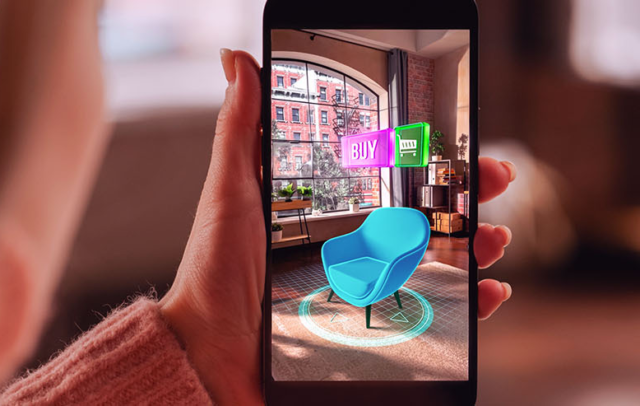Augmented Reality (AR) has transformed the mobile shopping experience by creating immersive and interactive environments that bridge the gap between physical and digital shopping. Here’s how AR enhances mobile shopping experiences:

Table of Contents
Toggle1. Virtual Try-Ons
- Fashion and Accessories: AR enables users to virtually try on clothing, shoes, and accessories using their smartphone cameras. This feature allows shoppers to see how items look on them without physically trying them on, reducing the chances of returns.
- Cosmetics: Beauty brands leverage AR to let customers test makeup products virtually. Users can see how different shades and products look on their skin, increasing confidence in their purchases.
2. Enhanced Product Visualization
- 3D Product Models: AR allows customers to view products in 3D and at scale. For example, furniture retailers can provide AR models of their products that customers can visualize in their own homes before buying.
- Contextual Viewing: Shoppers can see how products fit into their environments, helping them make informed decisions. This feature is especially useful for home decor and furniture purchases.
3. Interactive Shopping Experiences
- Gamification: Brands use AR to create interactive shopping experiences, such as scavenger hunts or AR-based games that engage users while they shop. These experiences can increase brand loyalty and customer retention.
- Storytelling: AR can enhance the storytelling aspect of a brand by allowing customers to interact with products through AR narratives. This approach makes the shopping experience more engaging and memorable.
4. Improved Product Information
- Visual Guides: AR can provide interactive product guides and tutorials. For instance, a user could point their device at a product, and AR could overlay information about features, usage instructions, or assembly guidance.
- Augmented Packaging: Some brands use AR-enabled packaging that customers can scan to reveal additional product information, videos, or customer reviews, enriching the shopping experience.
5. Personalized Recommendations
- Tailored Shopping Experiences: AR applications can analyze user preferences and behaviors to provide personalized product recommendations, enhancing the relevance of suggestions and increasing conversion rates.
- Real-Time Customization: Users can customize products in real time using AR, allowing them to see variations (like colors, sizes, or patterns) on their screens before making a decision.
6. Enhanced In-Store Experiences
- Navigation Assistance: AR can improve the in-store shopping experience by providing navigation aids that guide customers to product locations or highlight ongoing promotions when they scan their surroundings.
- In-Store AR Promotions: Retailers can deploy AR experiences within physical stores, offering interactive promotions or virtual content that enhances product discovery and engagement.
7. Reduced Returns and Increased Satisfaction
- Informed Purchases: By allowing customers to visualize products in their environment or try them virtually, AR reduces uncertainty and increases satisfaction, leading to fewer returns.
- Customer Confidence: The immersive experience provided by AR can boost customer confidence in their purchasing decisions, contributing to higher conversion rates.
8. Social Sharing and Engagement
- Shareable Experiences: Customers can capture AR experiences and share them on social media, creating organic brand exposure and encouraging peer recommendations.
- Collaborative Shopping: AR enables collaborative shopping experiences where users can share their virtual try-ons or product visualizations with friends and family, facilitating joint decision-making.
9. Data Collection and Insights
- Behavioral Analytics: AR applications can gather data on user interactions, preferences, and behaviors, providing valuable insights that brands can use to refine their product offerings and marketing strategies.
- User Feedback: Retailers can leverage AR experiences to solicit feedback, enhancing their understanding of customer needs and improving product development.
Conclusion
Augmented Reality is revolutionizing mobile shopping by providing engaging, interactive, and personalized experiences that bridge the gap between online and offline shopping. As AR technology continues to evolve, its integration into mobile shopping apps will become increasingly essential, enabling brands to meet customer expectations for innovative and immersive shopping experiences. By leveraging AR, retailers can not only enhance customer satisfaction but also drive sales and build brand loyalty in a competitive marketplace.


No responses yet